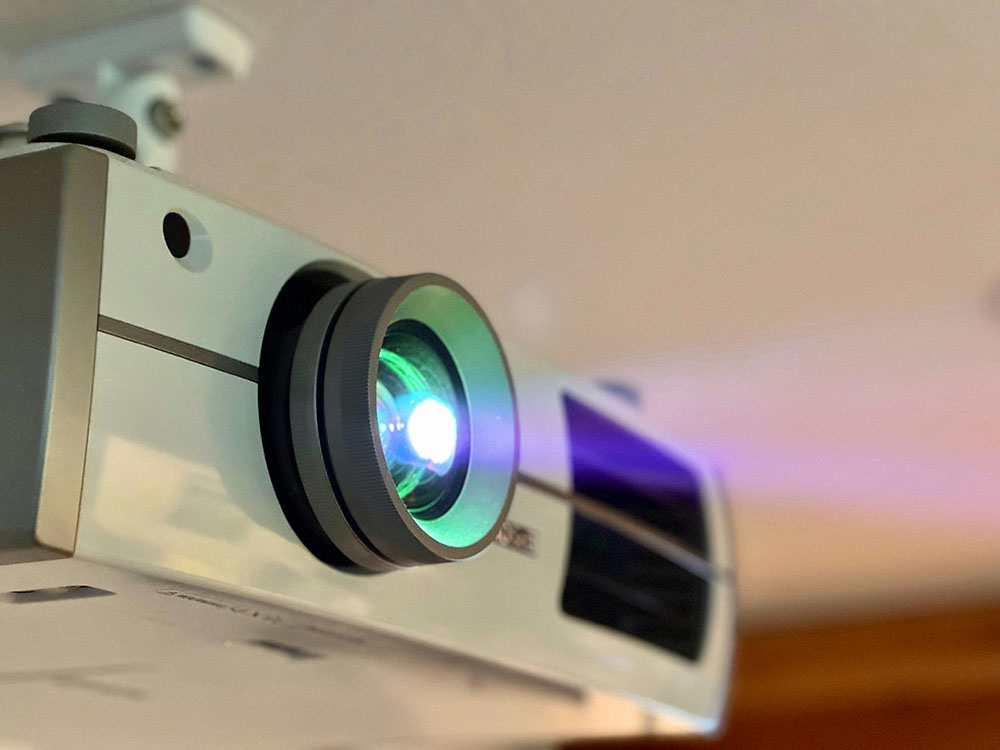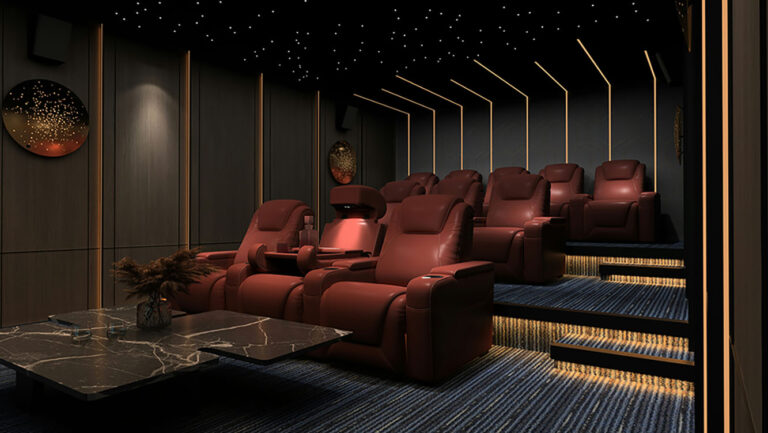You love that feeling you get when the lights dim, the music booms, and the projector screen fills with light. There’s something special about watching a movie in a theater, as opposed to your living room. After years of cramming friends and family onto couches and kitchen chairs for your weekly watch parties, or else fighting in vain against glares from windows or distracting street noise, you know it is time to give yourself the home theater of your dreams. But where do you start?
This guide will help you figure out the essentials of your home theater — where to build it, how to equip it, and how to make it your own — so you can enjoy that special feeling of going to the movies in your own home.
Where to Build Your Home Theater
Because home theaters are such distinctive spaces, you probably don’t want to take over a prominent area of your home, like your living room. Instead, you should choose a more private area, one that you can completely transform to suit your needs. In a good home theater, you will be able to eliminate natural light, reduce outside sound, and spread out to comfortably enjoy your chosen film. Some spaces that often make for a good home theater include:
Basement
The basement is a popular choice amongst movie buffs because it already offers many of the attributes of a good home theater: It’s dark, quiet, and expansive. You might choose to position your theater in a corner of the basement free from egress windows, so you don’t have to bother with blocking any natural light. If your basement is particularly large and empty — and especially if it is unfinished — you might opt to build an extra wall around your theater to create more privacy and better contain your movie décor.
Garage
Converting a garage into interior space is relatively easy and tends to be more affordable than building a new addition. Plus, regardless of whether you have a one- or two-car garage, you will have ample space for your home theater. The most difficult step of transforming a garage into a home theater is deciding what to do with the garage door; you might build a new wall in front of it if you expect to convert the theater back into a garage one day, or you can remove the door entirely and cover it in block or siding for a more permanent finish.
Shed
A large shed can make the perfect home theater space, but it might require some work to ensure its safety and soundness. To become a livable space, most sheds will need to be weatherproofed, insulated, sheetrocked, and floored. You may want to hire an electrician to wire the interior of your shed as well, as your home theater will require an extensive amount of electricity. Yet, even with all this work, a shed is a good option for your theater because it is separate from your home, allowing you to create some distance from your regular life as you delve into the stories on the big screen.
How to Equip Your Home Theater

A home theater is simply not a home theater without some essential equipment. Here’s what you need to give yourself the ultimate movie experience at home:
Audio-visual Equipment
Most home theaters utilize projectors and screens, which are more comfortable on the eyes and can be positioned to create enormous, clear images. You will also need to install a sound system to recreate theater-quality sound mixing. There is virtually no cap on the amount you can spend on audio-visual equipment for your home theater, so before you start researching options, you might set yourself a budget to prevent yourself from overspending in this one area.
Seating
To create a high-quality home theater experience, you cannot neglect the seats. However, before you spring for expensive theater-style recliners, you might consider whether other seating options might be more appropriate. Large, sectional-style couches can offer you more ways to relax while enjoying movies while providing plenty of seating for guests. Yet, if you opt for a sectional, you may need to plan for surfaces where you can place drinks, snacks, remotes, and other items.
Lighting
Lighting is important in every room, including your home theater. You don’t want your theater to be pitch-black, but you do want to avoid light spilling onto your screen, disrupting the image quality. Therefore, you should invest in directional lights, which allow you to determine where exactly light will shine in your space.
You might opt for smart lighting fixtures or bulbs, so you can control the color temperature, brightness, and more. When it comes to lighting and AV equipment installation, remember that DIY electrical work has its dangers. This is another case in which an extensive renovation that involves something like smart lighting would require rewiring, in which case you may want to enlist an electrician.
Soundproofing

The right location in your home will have naturally lower ambient sound to compete with your movies, but installing additional soundproofing can improve the quality of sound from your audio system and completely eliminate background noise. There are plenty of acoustic panels that are both functional and attractive for a home theater space.
Snack Machines
Sometimes, the snacks make the movie. You might think about installing machines for making your favorite snacks within your home theater space, so you have quick access to your favorite nibbles throughout your feature. Besides a popcorn popper, you might acquire other types of concession machines, like slushie makers, hot dog warmers, or nacho dispensers, or you might simply have a snack bar stocked with your favorite candies. This is one way to make your home theater truly unique.
You don’t have to be a millionaire to have a movie theater in your home — you just have to truly love movies. With the right space and equipment, you can make your home movie theater dreams come true.


